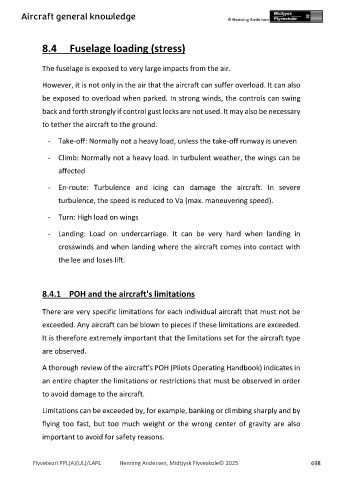Page 698 - PPL-engelsk 2025
P. 698
Aircraft general knowledge
8.4 Fuselage loading (stress)
The fuselage is exposed to very large impacts from the air.
However, it is not only in the air that the aircraft can suffer overload. It can also
be exposed to overload when parked. In strong winds, the controls can swing
back and forth strongly if control gust locks are not used. It may also be necessary
to tether the aircraft to the ground.
- Take-off: Normally not a heavy load, unless the take-off runway is uneven
- Climb: Normally not a heavy load. In turbulent weather, the wings can be
affected
- En-route: Turbulence and icing can damage the aircraft. In severe
turbulence, the speed is reduced to Va (max. maneuvering speed).
- Turn: High load on wings
- Landing: Load on undercarriage. It can be very hard when landing in
crosswinds and when landing where the aircraft comes into contact with
the lee and loses lift.
8.4.1 POH and the aircraft's limitations
There are very specific limitations for each individual aircraft that must not be
exceeded. Any aircraft can be blown to pieces if these limitations are exceeded.
It is therefore extremely important that the limitations set for the aircraft type
are observed.
A thorough review of the aircraft's POH (Pilots Operating Handbook) indicates in
an entire chapter the limitations or restrictions that must be observed in order
to avoid damage to the aircraft.
Limitations can be exceeded by, for example, banking or climbing sharply and by
flying too fast, but too much weight or the wrong center of gravity are also
important to avoid for safety reasons.
Flyveteori PPL(A)(UL)/LAPL Henning Andersen, Midtjysk Flyveskole© 2025 698

